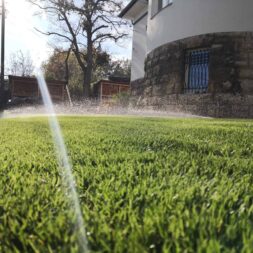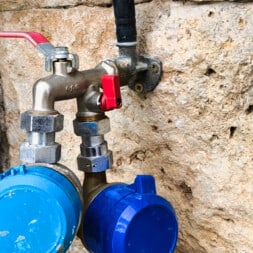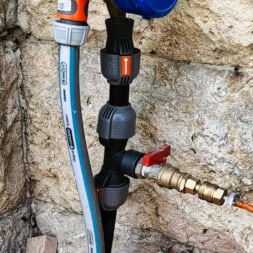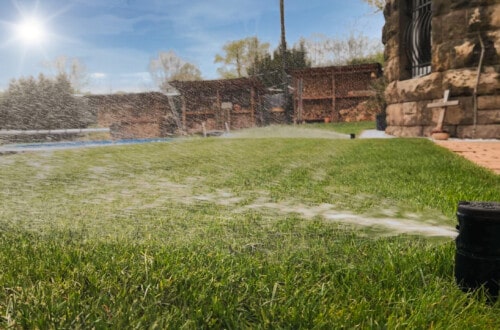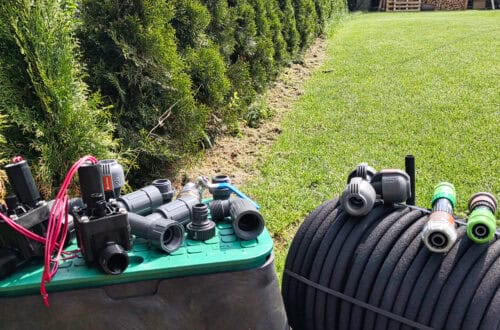
Winterizing and frost-proofing the lawn irrigation system
With the installation of my automatic and retractable lawn irrigation system from Hunter, I really did something good for my lawn this summer.
Depending on the weather, my lawn could and can be watered and I have no problems with bare or burnt patches in the lawn even during longer dry periods.
Nevertheless, every gardening season ends at the end of fall at the latest when winter arrives. And with lows in my region between just below zero and -25 C° in recent years, the irrigation system needs to be prepared accordingly for the cold season.
That means – the water has to get out!
Why drain the lawn irrigation before the frost?
Freezing and thawing water poses the greatest danger to water pipes and lawn sprinklers. The ice crushes the ABS plastic or PE and it bursts.
If the system is then put back into operation in the spring, the damage to the underground pipes sometimes remains undetected for a long time. Only a glance at the water meter shows that there is a problem.
Now the endless search for the broken part of the irrigation system begins. Once the fault has been found, a costly repair follows, which unnecessarily costs time and money.
To prevent this, it is important to completely empty the irrigation system before winter. This is the only way to protect the system from frost damage.

- Verhindert Frostschäden: Durch automatische Entwässerung bei Außerbetriebnahme des Sprinklersystems, Ventil öffnet bei einem Wasserdruck von unter ca. 0.2 bar im System
- Ideale Installation: Entwässerungsventile werden idealerweise an der tiefsten Stelle der Bewässerungsanlage montiert
- Drainage: Zur sicheren Drainage in eine Packung aus gewaschenem Grobkies einbauen
- Lieferumfang beinhaltet: 1x Gardena Entwässerungsventil
Is a drain valve sufficient for frost protection?
This is possible, for example, by installing drain valves. These valves allow the water to drain from the sprinklers and pipes as soon as the pressure drops below a predetermined level.
The advantage is virtually automation. The system is in fact permanently draining itself and does not provide any attack points for frost. A small disadvantage, however, is a certain waste of water since the water from the pipes gradually seeps into the subsoil after each sprinkling.
However, in my opinion, it is much more serious that an accurately planned and even better executed installation of the entire irrigation system must take place, since all pipes and sprinklers require a slope to the valve.
This would have been possible in my garden only at insanely high cost.
In the end, however, I also decided against installing drain valves because these valves can quickly get dirty and jammed and this therefore brings more trouble than benefit.
Zuletzt aktualisiert am 15. October 2025 um 21:49 . Ich weise darauf hin, dass sich hier angezeigte Preise inzwischen geändert haben können. Alle Angaben ohne Gewähr. (*) Bei den verwendeten Produktlinks handelt es sich um Affiliate Links. Ich bin nicht der Verkäufer des Produktes. Als Amazon-Partner verdiene ich an qualifizierten Verkäufen. Dein Preis ändert sich jedoch nicht.
Blow out lawn irrigation with compressed air
I decided to blow out the irrigation system with compressed air. In my view, this method is simple, efficient, not very time-consuming and, above all, safe!
In order to blow out my irrigation system with just under 75 meters of pipe and 12 sprinklers at the time (currently it is over 100 meters with 18 sprinklers), I had to install a compressed air adapter in a suitable location.
And although both my Hunter valve box and my RainBird valve box have a connection point, I decided to install the compressed air adapter directly after the water meter on the house wall.
I would also be able to drive there later with my compressor without any problems to connect it to the pipe system of my lawn irrigation system.
I screwed the adapter to the ¾” internal thread of a Gardena 25 T-piece connector using a reducer. This part of the line is shut off via a tap placed in between.
Please note that some compressors run oil-lubricated and the compressed air is therefore oily. In this case, either use an oil separator or a compressor without oil.

- Verarbeitung: Langlebig und Korrosionsbeständig
- Betriebsdruck: max. Betriebsdruck bis 35 Bar, Grobvakuum
- Temperaturbereich: -20 °C bis +100 °C
- Außengewinde 1/2"
- Inklusive Dichtungsring: Jeder Kupplungsstecker wird mit einem Dichtungsring geliefert.
Video 1 – Emptying the lawn irrigation system with compressed air
In the following video I show you how I blow out my lawn irrigation system with compressed air. Another video, on the construction of the compressed air connection, can be found further down in this entry.
I have posted a variety of other videos on my automatic garden watering playlist.
If you want to see more of me and my projects, have a look at my YouTube channel.
Video 2 – Blowing out lawn irrigation with compressed air
After I rebuilt and enlarged my lawn irrigation system, I also had to optimize the blowing out of the water. I captured the modifications for the compressed air connection to the lawn irrigation system in the following video.
In a 2nd video I show you how I am currently making my irrigation system frost-proof by blowing out the water with compressed air.
If you want to see more of me and my projects, have a look at my YouTube channel.
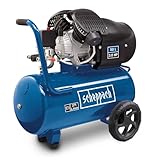
- Einsatzbereich: Mit seinem 50 Liter Kessel und seinen 371 L/min Ansaugleistung verfügt der Kompressor stehts über genügend Reserven für Anwendungen in Haus und Garage. Durch die Schnellanschlusskupplungen kann der Kompressor je nach Bedarf einfach umgerüstet werden
How do I blow the water out of the water pipes?
At the end of autumn, the water pipe from the house exterior connection is shut off, vented and drained.
I then connect my compressor to the piping system of my lawn irrigation system and open the individual valves by hand.
The compressor provides enough air at a pressure of 5 bar to blow the water through the individual circuits until it reaches the Hunter I20 lawn sprinklers. Hunter MP rotators are also easily blown free and drained.
I go about emptying each circuit one at a time and wait until there is no more water or spray coming out of the sprinklers.
The whole process takes me a good two hours – once a year.

- Systemtrenner Typ BA mit Monoblockkartusche zur Normgerechten Befüllung von Heizungsanlagen
- Entzinkungsfreies Messing-Gehäuse. 3/4“ ÜW für den Anschluss an ein vorhandenes Zapfventil
- Mit Schlauchanschluss und eingangsseitigem Schmutzsieb
- Zertifiziert nach EN 12729 und Beschluss 4/2007
- Max. Betriebsdruck: 10 bar. Max. Betriebstemperatur: 65°C
What is the system separator all about?
When operating a lawn irrigation system, and ultimately when operating any water lines outside the building, you must ensure that no water can flow back into the building’s mains.
This could carry bacteria, germs, and other contaminants from outdoor service water into the drinking water system.
Make sure that the air does not press the water back into the house network!
The water pipe should have a system separator. All shut-off cocks to the house mains must be closed.
Shut-off valves or a downward slope are NOT sufficient because (theoretically) certain factors could cause negative pressure in the house network. Then there would be the (theoretical) possibility that the water from the irrigation system would be sucked back into the house network.
The water in the outside pipes is “basically” considered contaminated and must not be allowed to come into contact with your home’s drinking water system – and consequently the next largest water supply pipe. come.
By the way, the same applies to the water in the outdoor faucet or the garden hose that supplies the pool.
All these water-bearing pipelines must be technically separated from the house network.
Special system separators are available for this purpose.
Before installation, however, find out what requirements your water supplier has!
Dieser Beitrag ist auch verfügbar auf:
English
Deutsch


